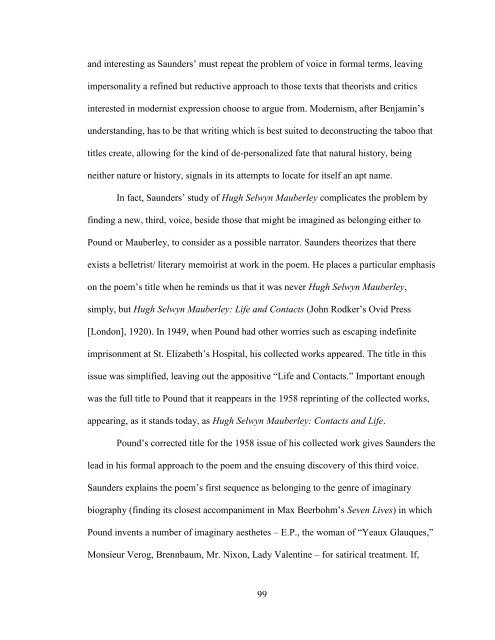TABOO: THE ACTUAL MODERNIST AESTHETIC, MADE REAL A ...
TABOO: THE ACTUAL MODERNIST AESTHETIC, MADE REAL A ...
TABOO: THE ACTUAL MODERNIST AESTHETIC, MADE REAL A ...
Create successful ePaper yourself
Turn your PDF publications into a flip-book with our unique Google optimized e-Paper software.
and interesting as Saunders‘ must repeat the problem of voice in formal terms, leaving<br />
impersonality a refined but reductive approach to those texts that theorists and critics<br />
interested in modernist expression choose to argue from. Modernism, after Benjamin‘s<br />
understanding, has to be that writing which is best suited to deconstructing the taboo that<br />
titles create, allowing for the kind of de-personalized fate that natural history, being<br />
neither nature or history, signals in its attempts to locate for itself an apt name.<br />
In fact, Saunders‘ study of Hugh Selwyn Mauberley complicates the problem by<br />
finding a new, third, voice, beside those that might be imagined as belonging either to<br />
Pound or Mauberley, to consider as a possible narrator. Saunders theorizes that there<br />
exists a belletrist/ literary memoirist at work in the poem. He places a particular emphasis<br />
on the poem‘s title when he reminds us that it was never Hugh Selwyn Mauberley,<br />
simply, but Hugh Selwyn Mauberley: Life and Contacts (John Rodker‘s Ovid Press<br />
[London], 1920). In 1949, when Pound had other worries such as escaping indefinite<br />
imprisonment at St. Elizabeth‘s Hospital, his collected works appeared. The title in this<br />
issue was simplified, leaving out the appositive ―Life and Contacts.‖ Important enough<br />
was the full title to Pound that it reappears in the 1958 reprinting of the collected works,<br />
appearing, as it stands today, as Hugh Selwyn Mauberley: Contacts and Life.<br />
Pound‘s corrected title for the 1958 issue of his collected work gives Saunders the<br />
lead in his formal approach to the poem and the ensuing discovery of this third voice.<br />
Saunders explains the poem‘s first sequence as belonging to the genre of imaginary<br />
biography (finding its closest accompaniment in Max Beerbohm‘s Seven Lives) in which<br />
Pound invents a number of imaginary aesthetes – E.P., the woman of ―Yeaux Glauques,‖<br />
Monsieur Verog, Brennbaum, Mr. Nixon, Lady Valentine – for satirical treatment. If,<br />
99
















